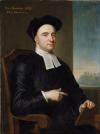Biography
George Berkeley (12 March 1685 - 14 January 1753), also known as Bishop Berkeley (Bishop of Cloyne), was an Irish philosopher whose primary achievement was the advancement of a theory he called "immaterialism" (later referred to as "subjective idealism" by others). This theory contends that individuals can only know directly sensations and ideas of objects, not abstractions such as "matter". The theory also contends that ideas are dependent upon being perceived by minds for their very existence, a belief that became immortalized in the dictum, "esse est percipi" ("to be is to be perceived"). His most widely-read works are A Treatise Concerning the Principles of Human Knowledge (1710) and Three Dialogues between Hylas and Philonous (1713), in which the characters Philonous and Hylas represent Berkeley himself and his older contemporary John Locke. In 1734, he published The Analyst, a critique of the foundations of infinitesimal calculus, which was influential in the development of mathematics.
Berkeley was born at his family home, Dysart Castle, near Thomastown, County Kilkenny, Ireland, the eldest son of William Berkeley, a cadet of the noble family of Berkeley. He was educated at Kilkenny College and attended Trinity College, Dublin, completing a Master's degree in 1707. He remained at Trinity College after completion of his degree as a tutor and Greek lecturer.
His earliest publication was on mathematics, but the first that brought him notice was his Essay Towards a New Theory of Vision, first published in 1709. In the essay, Berkeley examined visual distance, magnitude, position and problems of sight and touch. Though giving rise to much controversy at the time, its conclusions are now accepted as an established part of the theory of optics.
The next publication to appear was the Treatise Concerning the Principles of Human Knowledge in 1710, which was followed in 1713 by Three Dialogues between Hylas and Philonous, in which he propounded his system of philosophy, the leading principle of which is that the world as represented to our senses depends for its existence, as such, on being perceived.
Of this theory, the Principles gives the exposition and the Dialogues the defence. One of his main objectives was to combat the prevailing materialism of the time. The theory was largely received with ridicule; while even those, such as Samuel Clarke and William Whiston, who did acknowledge his "extraordinary genius," were nevertheless convinced that his first principles were false.
Shortly afterwards, Berkeley visited England, and was received into the circle of Addison, Pope and Steele. In the period between 1714 and 1720, he interspersed his academic endeavours with periods of extensive travel in Europe, including one of the most extensive Grand Tours of the length and breadth of Italy ever undertaken. In 1721, he took Holy Orders in the Church of Ireland, earning his doctorate in divinity, and once again chose to remain at Trinity College Dublin, lecturing this time in Divinity and in Hebrew. In 1724, he was made Dean of Derry.
In 1725, he formed the project of founding a college in Bermuda for training ministers for the colonies, and missionaries to the Indians, in pursuit of which he gave up his deanery with its income of £1100.
In 1728, he married Anne Forster, daughter of the Lord Chief Justice of Ireland. He then went to America on a salary of £100. He landed near Newport, Rhode Island, where he bought a plantation in Middletown, Rhode Island - the famous "Whitehall". He lived at the plantation while he waited for funds for his college to arrive. The funds, however, were not forthcoming and in 1732 he left Rhode Island and New England and returned to London. While living on London's Saville Street, he took part in the efforts to create a home for the city's abandoned children. The Foundling Hospital was founded by Royal Charter in 1739 and Berkeley is listed as one of its original governors. In 1734, he was appointed Bishop of Cloyne in Ireland. Soon afterwards, he published Alciphron, or The Minute Philosopher, directed against both Shaftesbury and Bernard de Mandeville; and in 1735-37 The Querist.
His last two publications were Siris: Philosophical reflexions and inquiries concerning the virtues of tar-water, and divers other subjects connected together and arising from one another (1744) and Further Thoughts on Tar-water (1752). Pine tar is an effective antiseptic and disinfectant when applied to cuts on the skin, but Berkeley argued for the use of pine tar as a broad panacea for disease in general. It is said that his 1744 book on the medical benefits of pine tar was his best-selling book in his lifetime.
He remained at Cloyne until 1752, when he retired and went to Oxford to live with his son. He died soon afterward and was buried in Christ Church Cathedral, Oxford. His affectionate disposition and genial manners made him much loved and held in warm regard by many of his contemporaries. ..






